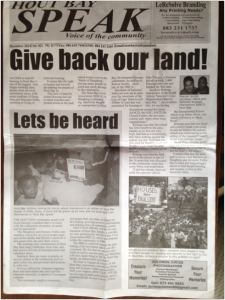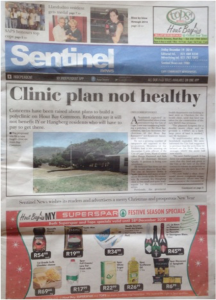Who speaks for the community? A tale of two newspapers in Hout Bay
In the first instalment of CORD’s new blog series, the University of the Western Cape’s Laurence Piper reflects on Cape Town’s prevailing media landscape. He describes a recent encounter with two newspapers from the city’s Hout Bay area, and how they represent the lives of white and black citizens in different ways. These representations, Piper suggests, not only reflect but also feed into inequalities that have long plagued the city. He concludes by musing on the rise of social media, and what it means for those seeking to redress injustice and have their voices heard. Click here to access the book chapter on which this entry is based.
By Laurence Piper
One day while doing research on urban violence in the poor settlement of Imizamo Yethu in Hout Bay, Cape Town, I found a pile of newspapers called Hout Bay Speak at the local library. This was unusual. I had been to library many times – it was near the venue in which we did workshops with residents on crime and insecurity – but this was the first time I found this newspaper.
Usually on a Friday you can find a copy of the Sentinel in the Imizamo Yethu library, but if not there, then certainly at the police station at the entrance to the settlement. Mostly, newspapers like the Sentinel are full of stories of local school children who made provincial teams, reports from recent charity events, friendly ‘reviews’ of local eateries, and the odd news story, especially around crime. Mostly however, newspapers like the Sentinel are vehicles for the adverts that make them free.
At first glance, Hout Bay Speak looked different from the Sentinel. It is printed on A4 white paper as opposed to newsprint; it is in black and white only; and it has very little advertising.
But perhaps the main way that Hout Bay Speak was different was in the overtly political nature of its stories. The headline of the edition read ‘Give back our land!’, and was about the inability of poor residents to access land in Hout Bay given the prohibitive property prices, and the decision by the city to build a school rather than houses in Imizamo Yethu.
The demand for inclusion in land is echoed on the front page by demand for political recognition. Thus the other major story on the front page is headed ‘Lets be heard’ that asks readers to submit stories to Hout Bay Speak as the (poor black) ‘Imizamo Yethu and Hangberg community voices are not given proper exposure in the media’. Notably, the by-line of Hout Bay Speak is ‘voice of the community’.
To even the casual outside observer it is clear that Hout Bay Speak has a point. A glance at any issue of the Sentinel confirms that it imagines Hout Bay from the viewpoint of the white and wealthy suburbs. Thus, the stories that dominate are from the middle-class and mostly white world of schools, philanthropic organisations, restaurants, roadworks and local artists and sports stars. Most of the people in the pictures are not from poor, black areas and neither are the newspaper scribes.
Lastly, while the Sentinel does deal with local politics, it is much less prominent than in Hout Bay Speak, and invariably from the view of the local Residents Association. The story about ‘Clinic plan not healthy’ takes the side of the Resident’s association in the debate over where to locate the new clinic. Rooted in the white and wealthy suburbs, the resident’s association does not want the clinic located centrally close to the wealthy suburbs, as ‘it will be too costly for poor residents to travel’.
The residents association is happy to speak for the interests of the poor against the express views of both the leaders from Imizamo Yethu and the Hout Bay Health Forum. Most of the time the lead stories in the Sentinel are about crime.
At the heart of the difference between these two papers is advertising. The Sentinel is available free throughout Hout Bay because of local advertising.
Clearly, advertisers target consumers, and in Hout Bay the white and wealthy are the most important consumers. Thus, perhaps we should not be surprised that the Sentinel targets the suburbs, even though the majority of residents in Hout Bay live in poor, black townships.
In significant part, the racialisation of class is a legacy of apartheid that prevented black people from accessing both political and economic rights. While oppressive laws have been repealed, the wealth differentials from the past largely endure.
In addition, Hout Bay has a significant proportion of foreign migrants, both wealthy ‘European swallows’ who have bought holiday property in the area, and poor refugees from Africa who come for work. This has further exacerbated social divides linked to race and class.
So maybe Hout Bay Speak has a point. Maybe the removal of apartheid laws is not enough to ensure that black residents of Hout Bay can access affordable land, housing and health – amongst other needs – and that they have the resources to express themselves in the public realm. Maybe initiatives like Hout Bay Speak are an important corrective to the enduring power of whiteness through its link to money in an era of neo-liberal globalization.
However, Hout Bay Speak has its problems too. First, it is a partisan paper. The leaders listed in its pages are all aligned to the political party, the African National Congress (ANC), even though there are important leaders and organisations in both Imizamo Yethu and Hangberg that are not part of the ANC. Therefore, while it offers an important alternative voice for poor residents, Hout Bay Speak it is limited to those aligned to a political party. This is a large and important group, but not inclusive of all poor residents, and probably a group beginning to shrink as the ANC’s popularity drops.
Second, and more importantly, I have yet to see the second edition of Hout Bay Speak. Perhaps I missed it, but the point is that the Sentinel comes out regularly every Friday and is relatively accessible, where Hout Bay Speak is not. If the views of poor, black residents are to find expression in the public realm, they need a more reliable medium than an irregular, partisan newspaper with a small circulation.
In this regard, social media offers a new and intriguing opportunity. There are already three or four large Hout Bay relative Facebook groups and where, unlike out two newspapers, voice is not mediated so much by either wealthy or party allegiance. Perhaps social media will offer a new public for poor and wealthy, and black and white to influence more equitably the debates on life in Hout Bay.
Reference
Laurence Piper, Bettina von Lieres and Fiona Anciano. 2017. ‘The tale of two publics: Media, political representation and citizenship in Hout Bay, Cape Town’, in Anthea Garman and Herman Wasserman (eds). Media and Citizenship: Between Marginalisation and Participation. Pretoria: HSRC Press. ISBN: 978-0-7969-2556-5., pp. 120-138.


